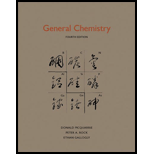
Concept explainers
(a)
Interpretation:
Chemical equation given below has to be balanced.
Concept Introduction:
Steps followed to obtain balanced chemical equation:
- Chemical formulas of the products and reactants are written. Individual reactants and products are separated using plus sign while the reactants are separated from products by an arrow.
- Elements that appear only once on the reactant side and product side is balanced first. Subscript should not be changed in chemical formula while balancing coefficients can be added until the total number of atoms of an element becomes equal on reactant and product side.
- Other elements present also balanced in the same way by adding balancing coefficients.
- Final check has to be performed in order to check that each element that is present in the chemical equation is balanced.
- Symbols have to be added for solids, liquids gases and aqueous solutions to indicate the physical state of the known reactants and products.
(a)
Explanation of Solution
Chemical equation given is shown below.
Above chemical equation is not balanced. There is one potassium atom on the reactant side while there are two potassium atoms on the product side. Adding coefficient
In the above equation, there are four hydrogen atoms on the reactant side while there are only two hydrogen atoms on the product side. Adding coefficient
(b)
Interpretation:
Chemical equation given below has to be balanced.
Concept Introduction:
Refer part (a).
(b)
Explanation of Solution
Chemical equation given is shown below.
Above chemical equation is not balanced. There are three lithium atoms on the reactant side while there is only one lithium atom on the product side. Adding coefficient
In the above equation, there are two hydrogen atoms on the reactant side while in the product side a total of six hydrogen atoms are present. Adding coefficient
(c)
Interpretation:
Chemical equation given below has to be balanced.
Concept Introduction:
Refer part (a).
(c)
Explanation of Solution
Chemical equation given is shown below.
Above chemical equation is not balanced. There are four aluminium atoms on the reactant side but in the product side there is only one aluminium atom. Adding coefficient
In the above chemical equation, there is only one chlorine atom on the reactant side while in the product side there are twelve chlorine atoms. Adding coefficient
In the above chemical equation, there are twelve hydrogen atoms in the reactant side while in the product side there are four hydrogen atoms. Adding coefficient
(d)
Interpretation:
Chemical equation given below has to be balanced.
Concept Introduction:
Refer part (a).
(d)
Explanation of Solution
Chemical equation given is shown below.
Above chemical equation is not balanced. There is one bromine atom on the reactant side and two bromine atoms on the product side. Adding coefficient
Want to see more full solutions like this?
Chapter 3 Solutions
General Chemistry
 ChemistryChemistryISBN:9781305957404Author:Steven S. Zumdahl, Susan A. Zumdahl, Donald J. DeCostePublisher:Cengage Learning
ChemistryChemistryISBN:9781305957404Author:Steven S. Zumdahl, Susan A. Zumdahl, Donald J. DeCostePublisher:Cengage Learning ChemistryChemistryISBN:9781259911156Author:Raymond Chang Dr., Jason Overby ProfessorPublisher:McGraw-Hill Education
ChemistryChemistryISBN:9781259911156Author:Raymond Chang Dr., Jason Overby ProfessorPublisher:McGraw-Hill Education Principles of Instrumental AnalysisChemistryISBN:9781305577213Author:Douglas A. Skoog, F. James Holler, Stanley R. CrouchPublisher:Cengage Learning
Principles of Instrumental AnalysisChemistryISBN:9781305577213Author:Douglas A. Skoog, F. James Holler, Stanley R. CrouchPublisher:Cengage Learning Organic ChemistryChemistryISBN:9780078021558Author:Janice Gorzynski Smith Dr.Publisher:McGraw-Hill Education
Organic ChemistryChemistryISBN:9780078021558Author:Janice Gorzynski Smith Dr.Publisher:McGraw-Hill Education Chemistry: Principles and ReactionsChemistryISBN:9781305079373Author:William L. Masterton, Cecile N. HurleyPublisher:Cengage Learning
Chemistry: Principles and ReactionsChemistryISBN:9781305079373Author:William L. Masterton, Cecile N. HurleyPublisher:Cengage Learning Elementary Principles of Chemical Processes, Bind...ChemistryISBN:9781118431221Author:Richard M. Felder, Ronald W. Rousseau, Lisa G. BullardPublisher:WILEY
Elementary Principles of Chemical Processes, Bind...ChemistryISBN:9781118431221Author:Richard M. Felder, Ronald W. Rousseau, Lisa G. BullardPublisher:WILEY





